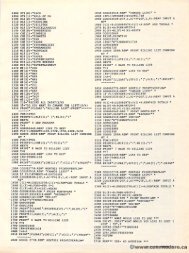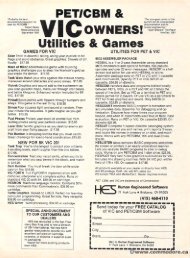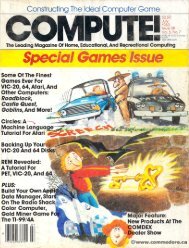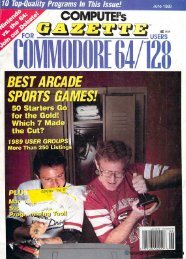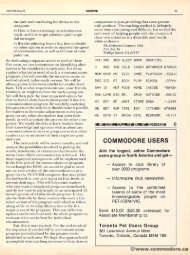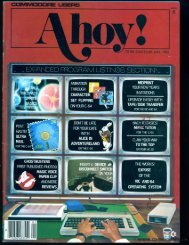You also want an ePaper? Increase the reach of your titles
YUMPU automatically turns print PDFs into web optimized ePapers that Google loves.
May, May. 1Q82lssue 1982, Issue 24 COMPUTE:! COMPUTE! 105<br />
Learning With<br />
Learning With<br />
<strong>Computers</strong><br />
C~mputers<br />
Glenn Kleiman and Mary Humphrey<br />
Glenn Kleiman and Mary Humphrey<br />
Teaching Tools:<br />
Microcomputer Services<br />
PO P.O. Box 50065<br />
Po Palo AitaCA Alto. 94303<br />
Preschool Computing<br />
Several friends of ours recently used computers<br />
for the first time. After we helped them get started,<br />
they enjoyed themselves and were eager to do<br />
more with the computer. They also had many<br />
comme nts, both positive and negative, about the<br />
comments, both positive and negative, about the<br />
programs they used. This is all very familiar- r - most<br />
people we have introduced to compute rs have<br />
people we have introduced to computers have<br />
responded in the same way. The difference is that<br />
these particular friends are between two-and-a-half<br />
and five years old. .<br />
Personal computers can be programmed to<br />
present lessons and games which encourage children's<br />
learning ng of such things as color names,<br />
numbers, leners, letters, vocabulary, and perceptual skills. s.<br />
Whi le using computers in these ways, childre n also<br />
While using computers in these ways, children also<br />
take their first li steps towards computer literacy.<br />
They realize that computers are an integral part of<br />
the world, and they learn about the keyboard, the<br />
cursor, disks and other aspects of computer use.<br />
We find children to be far more comfortable playing<br />
with comput.ers computers than are most adults.<br />
Programs For Preschoolers<br />
A numberr of available programs are suitable for<br />
preschool children. Some of these programs are<br />
designed for children to use by themselves (once<br />
they are helped to start), others are for t.wo two or<br />
more childrenn to use together, aand others are<br />
designed for three way interactions among child,<br />
adult and computer. The programs all use graphics<br />
and minimize the need for reading. Some also<br />
make good use of sound. Many of these programs<br />
make good use of sound. Many of these programs<br />
explicitly teach certain things, others are designed<br />
for the child to explore and create. The following<br />
programs are our young friends'<br />
favorites.<br />
HodgeH Podge (for Apple computers, from<br />
Dynacomp, Inc. 1427 Monroe Ave., Rocheste r, NY<br />
1461 8) . T he instructions accompanying this program<br />
describe it as a "surreptitious learning" program.<br />
When any key is pressed, a song, animation,<br />
animation.<br />
Dynacomp, Inc. 1427 Monroe Ave., Rochester, NY<br />
14618). The instructions accompanying this pro<br />
or picture related to the key is presented. Press A<br />
for an apple, B for a bear, C for a cat, D for a dog<br />
and so on. Some keys result in more elaborate<br />
displays. Press F and a farm is shown. n. "Old McDonald<br />
Had a Fa rm" is played and, at the appropriate<br />
nald Had a Farm" is played and, at the appropriate<br />
time, aann animal appears -—aa different animal each<br />
time. Press U and steps appear, a marker moves up<br />
the steps while tones goingg up the scale are played.<br />
Press' and the alphabet song is played , with each<br />
Press } and the alphabet song is played, with each<br />
letter appearingg in turn. The numbers I 1 through 8<br />
each playa a musical note and show that note on a<br />
staff. Zero turns the numberr keys into a miniature<br />
piano so childrenn play their own tunes. Other keys<br />
result in displays illustrating addition facts aand the<br />
concepts of smaller and bigger. T his program is<br />
concepts of smaller and bigger. This program is<br />
packed with easy to use educational features which<br />
can entertain a child for some tilne.<br />
time.<br />
AbovelBelowlLeftlRight AbovelBelow/LeJI/Righl (for {for Apple computers,<br />
from Advanced Learning Technology, Inc., 4370<br />
Alpine Road, Suite 201, I, Portola Valley, CA 94025).<br />
T his set of programs teaches' the concepts give n in<br />
This set of programs teaches the concepts given in<br />
its title. One program m is on above and below, one on<br />
lefi (eft and 'right, and one on all four terms. Each prog<br />
ram follows a simi lar sequence. For example, to<br />
gram follows a similar sequence. For example, to<br />
use the Above/Below program a blue bar (provided<br />
with the programs) is placed across the keyboard,<br />
with the programs) is placed ac ross the keyboard,<br />
di viding it into two sections, one for above and one<br />
dividing it into two sections, one for above and one<br />
for below. The program begins by showingg a horizontal<br />
blue line across the middle of the screen. In<br />
the first part of the program the child can press<br />
any key. Pressing a key above the blue e keyboard<br />
divider results in a colored bar appearing above<br />
the blue line onn the screen. Pressingg a key below<br />
the keyboard divider results in a colored bar below<br />
the blue line on the screen. Tones play each time a<br />
key is pressed. . In the second part off the program<br />
the child is shown an incomplete colored bar either<br />
above Or or below the blue line. Pressing aann appropriate<br />
key completes the bar. The next two parts of<br />
the program are similar, but two boxes are shown<br />
on the screen, one above the other. Pressing keys<br />
on the screen, one above the other. Pressing keys<br />
causes either the upper or the lower box to change<br />
color. I n the fin al part of the program a colo rful<br />
color. In the final part of the program a colorful<br />
picture is created and the colors change in response<br />
to the child's key presses. Keys above the divider<br />
cause a change in the top half of the picture, keys<br />
below the divider cause a change in the bottom<br />
half. This program uses colors, music and pretty<br />
pictures to hold the child's attention.<br />
Humble Bumble Cames Games (for Apple computers, also from<br />
Advanced Learning Technology, see address<br />
above) is a set of six programs for beginning numberr<br />
skills. T he first program is a Guess My Numbe r<br />
skills. The first program is a Guess My Number<br />
game, suitable for older preschoolers. A number<br />
line appears with the numbers zero to five. The<br />
child guesses a number, and is told whethe r his<br />
child guesses a number, and is told whether his<br />
guess is less than, greater than, or equal to, the





